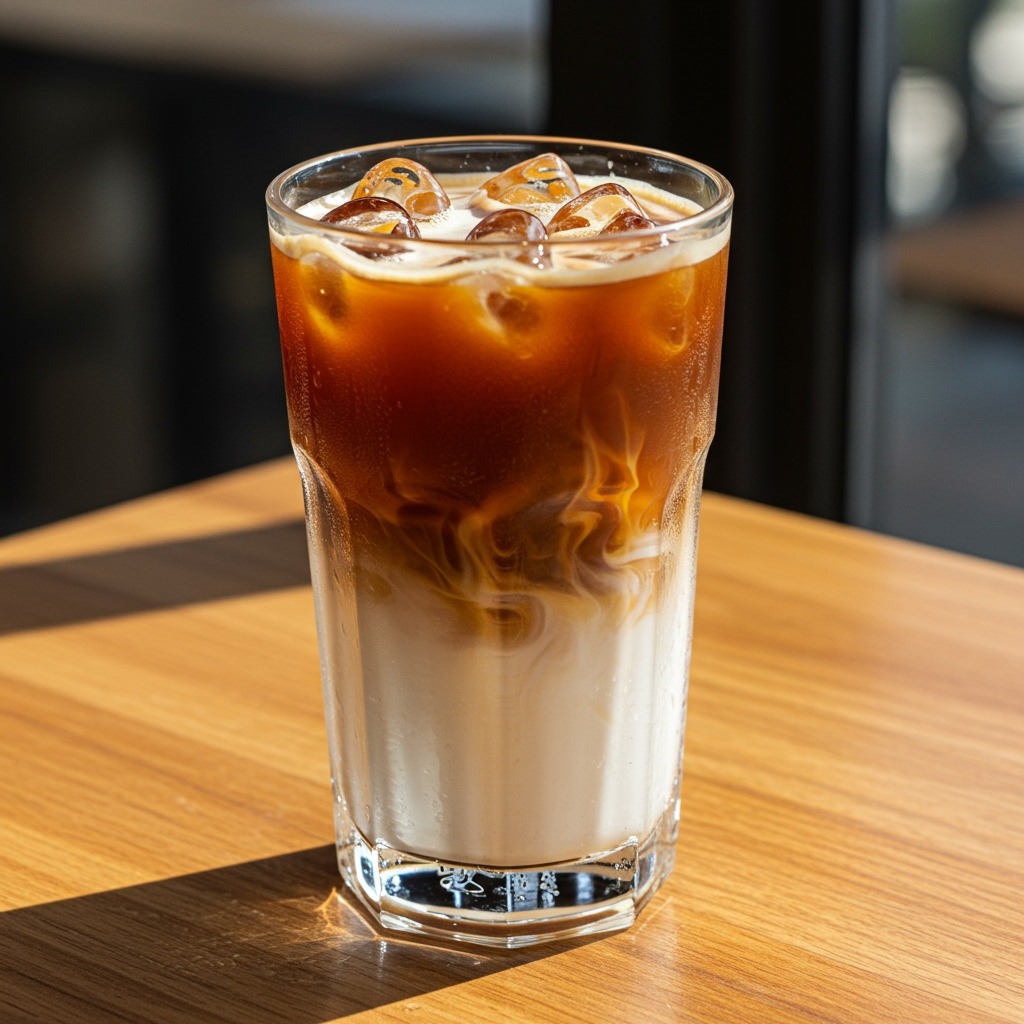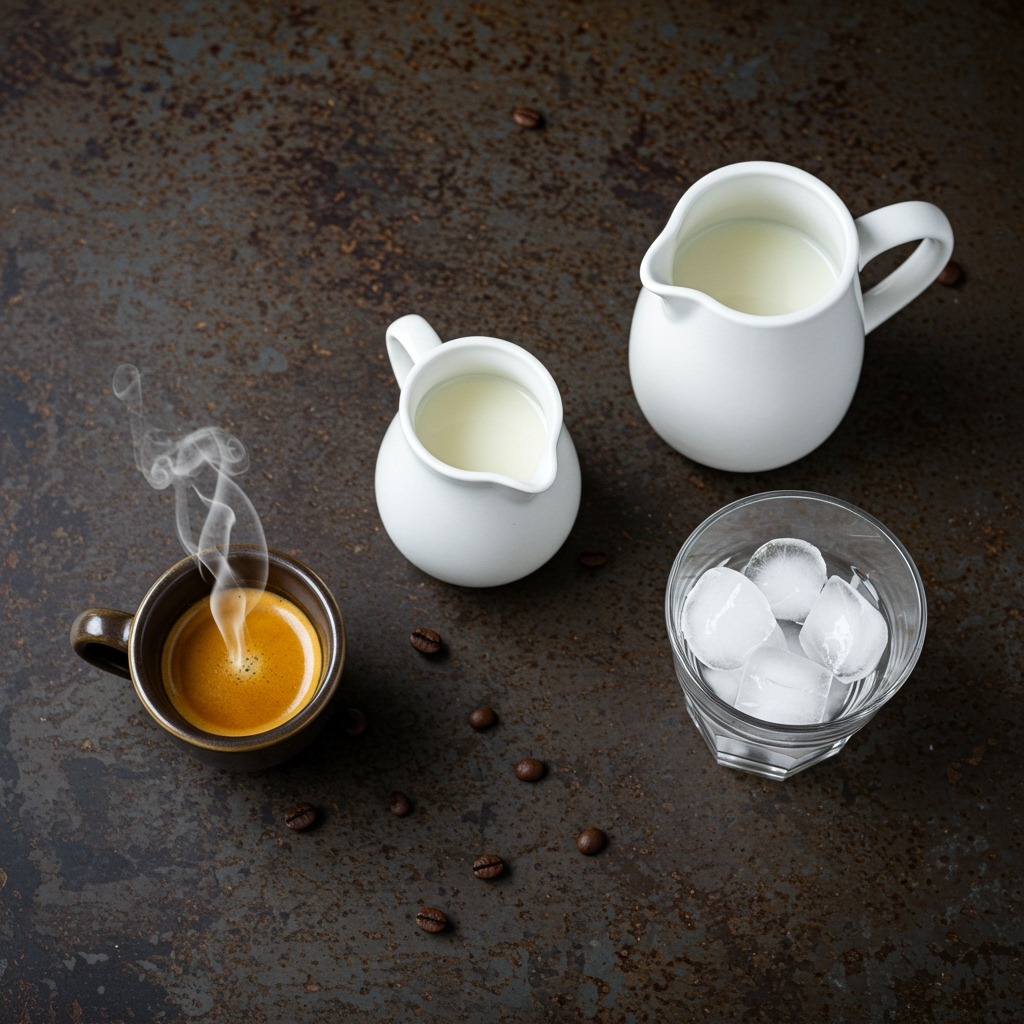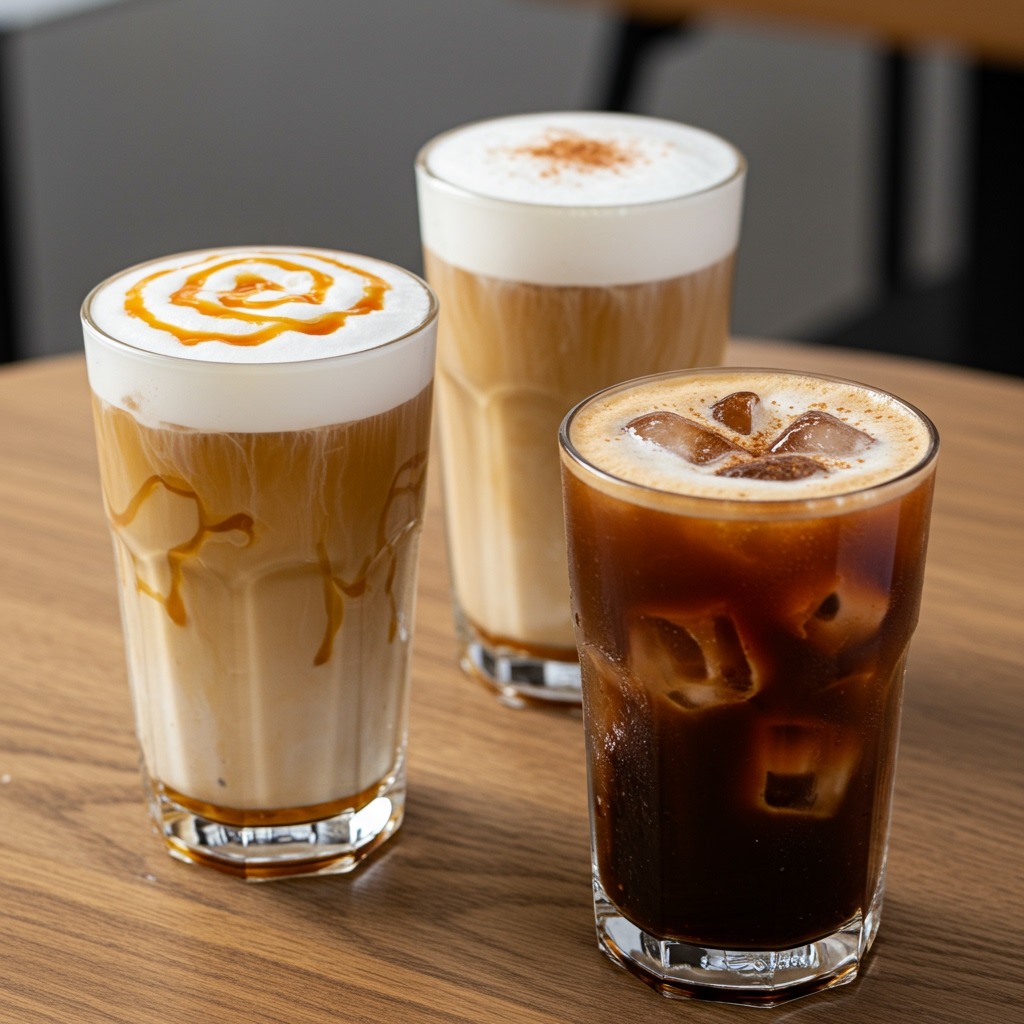There’s nothing quite like it. That satisfying clink of ice against glass, the smooth, rich coffee swirling with creamy milk, and that instant burst of refreshing flavor. It’s the iced latte, and it’s become a beloved staple for coffee lovers, especially when the weather warms up.
But here’s a thought: How many times have you craved that perfect iced latte only to face a long line at the coffee shop and an ever-increasing price tag? What if you could recreate that café-quality experience right in your own kitchen? Imagine customizing every sip to your exact preference, all while saving money and impressing your friends.

You absolutely can! This isn’t some secret barista-only magic. Making a fantastic iced latte at home is surprisingly simple once you know the core principles. This guide will equip you with all the knowledge, tips, and tricks to become your own favorite barista. Get ready to ditch the drive-thru and embrace the art of the perfect, personalized iced latte.
What Exactly is an Iced Latte? Demystifying the Drink
Before we dive into creation, let’s nail down what an iced latte truly is and how it stands apart from its cold coffee cousins.
Core Components: Espresso, Milk, Ice
At its heart, a classic iced latte is a simple, elegant concoction built on three pillars:
- Espresso: This is the soul of your latte. A concentrated shot (or two) of rich, intensely flavored coffee.
- Milk: The creamy body of the drink. It mellows the espresso’s intensity and adds a luscious texture.
- Ice: The essential cooler, bringing down the temperature and providing that refreshing chill.
Unlike a hot latte, which features steamed milk and a thin layer of foam, an iced latte uses cold milk, often poured directly over ice. The beauty lies in its simplicity and the delightful contrast of strong coffee with cold, sweet milk.
The Difference from Other Iced Coffees
It’s easy to get confused with all the cold coffee options out there. Here’s a quick breakdown:
- Iced Latte vs. Iced Coffee: An iced latte uses espresso as its coffee base, which is a highly concentrated shot. Iced coffee, on the other hand, typically uses regular brewed coffee (like from a drip coffee maker), which is much less concentrated. This difference in coffee strength and brewing method gives them distinct flavor profiles.
- Iced Latte vs. Cold Brew: Cold brew is a coffee concentrate steeped in cold water for many hours, resulting in a smooth, low-acid coffee. While you can use cold brew concentrate as a base for an “iced latte” (adding milk and ice), a true iced latte traditionally uses espresso. Cold brew tends to be less bitter and bolder than espresso.
- Iced Latte vs. Iced Cappuccino: An iced cappuccino has similar ingredients to an iced latte (espresso, milk, ice) but typically features a significant layer of cold foam on top, creating a lighter, airier texture, more akin to its hot counterpart.
Caffeine Content: What to Expect
The caffeine content in your iced latte largely depends on the number of espresso shots you use and the type of coffee beans.
- Standard Espresso Shot: A single shot (about 1 ounce) of espresso typically contains around 60-75 milligrams of caffeine.
- Double Shot Latte: Most standard iced lattes at coffee shops use a double shot, putting them in the 120-150 mg range.
- Factors Affecting Caffeine: The type of coffee bean (Robusta generally has more caffeine than Arabica), the roast level, and how long the espresso shot is pulled can all subtly influence caffeine content.
Knowing this helps you control your caffeine intake and tailor your drink to your needs, whether you’re looking for a gentle pick-me-up or a serious jolt.

Crafting Your Perfect Iced Latte: Step-by-Step Guide
Ready to get hands-on? Let’s walk through the process of making a classic iced latte at home. It’s easier than you think!
Ingredients Breakdown: The Foundation of Flavor
Quality ingredients make all the difference.
- Coffee: Espresso is King, but Alternatives Exist
- Espresso: This is the gold standard. Its rich, concentrated flavor stands up beautifully to milk and ice.
- How to Make Espresso:
- Espresso Machine: The ideal choice for authentic espresso. Pull 1-2 shots (1-2 ounces total).
- Moka Pot: A stovetop brewer that makes strong, concentrated coffee, a great alternative if you don’t have an espresso machine.
- AeroPress: Can produce a very strong coffee concentrate similar to espresso.
- French Press: You can make a very strong, concentrated coffee by using a higher coffee-to-water ratio and steeping for longer. This works as a decent substitute for espresso in an iced latte.
- How to Make Espresso:
- Strong Brewed Coffee (Cold Brew or Drip): If espresso isn’t an option, use very strong brewed coffee or cold brew concentrate. Just be aware the flavor profile will be slightly different. For example, if you use drip coffee, use less water than usual to make it stronger.
- Espresso: This is the gold standard. Its rich, concentrated flavor stands up beautifully to milk and ice.
- Milk: Dairy vs. Non-Dairy Options
The choice of milk significantly impacts the flavor and creaminess.
- Dairy: Whole milk is traditionally used for its richness. 2% milk is a popular lighter option.
- Non-Dairy:
- Oat Milk: Excellent for lattes, offering a creamy texture and subtle sweetness.
- Almond Milk: Lighter in texture, with a slightly nutty flavor.
- Soy Milk: A classic, provides a rich, slightly thicker texture.
- Coconut Milk: Adds a distinct coconut flavor. Choose a barista blend for best results.
- Sweetener: To Taste
- Simple Syrup: The best choice for cold drinks as it mixes easily without gritty residue. You can make it by dissolving equal parts sugar and hot water.
- Granulated Sugar/Brown Sugar: Can be used, but stir well to dissolve.
- Honey/Maple Syrup: Add a natural sweetness and unique flavor.
- Flavored Syrups: Vanilla, caramel, hazelnut – readily available and add instant flavor.
- Ice: Quality Matters
- Use fresh, clean ice. Avoid ice that has absorbed freezer odors. Large ice cubes melt slower, diluting your drink less quickly.
Basic Recipe: The Classic Iced Latte
This is your foundation. Once you master this, you can experiment!
Ingredients:
- 1-2 shots (approx. 1-2 oz) chilled espresso or strong coffee
- 1 cup (8 oz) cold milk of choice
- 1-2 tbsp (or to taste) simple syrup or other sweetener
- Plenty of ice
Instructions:
- Brew Your Coffee: Pull 1-2 shots of espresso and let them cool down to at least room temperature. Chilling them in the fridge for a few minutes is even better. If using strong brewed coffee, make it ahead of time and chill it.
- Sweeten (Optional): If you’re adding sweetener, add it to your chilled espresso or strong coffee and stir until dissolved. This ensures it fully incorporates.
- Fill Your Glass: Fill a tall glass almost to the top with ice.
- Add Milk: Pour the cold milk over the ice.
- Pour Coffee: Slowly pour the chilled espresso (or strong coffee) over the milk and ice. Watch the beautiful layers form!
- Stir & Enjoy: Give it a gentle stir to combine all the ingredients. Sip and savor your homemade latte coffee.
Equipment You’ll Need:
You don’t need a full café setup to make a great iced latte.
- Espresso Machine (Ideal): For true espresso.
- Alternative Coffee Makers: Moka pot, AeroPress, or French press for strong coffee concentrate.
- Tall Glass: A 16-ounce glass is standard.
- Measuring Tools: For accuracy in coffee and milk.
- Spoon: For stirring.

Elevate Your Iced Latte: Flavor & Texture Hacks
The basic iced latte is fantastic, but its true power lies in its versatility. Get creative and customize your drink with these simple hacks.
Milk Magic: Cold Foam & Froth
Who said foam is just for hot lattes? Cold foam adds a delightful, airy texture to your iced drink.
- How to Create Cold Foam:
- Handheld Frother: The easiest method. Pour a small amount of cold milk into a mug and use a handheld frother until it’s light and foamy.
- Whisk: Vigorously whisk cold milk in a bowl until frothy.
- Jar Shake: Pour cold milk into a jar with a tight lid, then shake vigorously for 30-60 seconds until foamy.
- Adding to Your Latte: Gently spoon the cold foam over your finished iced latte for a beautiful layered look and a luxurious mouthfeel.
Syrup Sensations: Homemade vs. Store-bought
Flavor syrups are your playground for customization.
- Classic Flavors:
- Vanilla: A timeless favorite, adding a smooth, comforting sweetness.
- Caramel: Rich and buttery, perfect for a caramel iced latte. You can even drizzle extra caramel sauce inside the glass before adding ingredients for a “caramel wall” effect.
- Hazelnut: Adds a warm, nutty aroma and flavor.
- Seasonal Inspirations: Don’t limit yourself!
- Pumpkin Spice: A fall favorite.
- Peppermint: Festive for winter.
- Lavender/Rose: For unique floral notes in spring/summer.
- Homemade Simple Syrups: Experiment by infusing simple syrup with spices (cinnamon stick, star anise), herbs (mint), or fruits (berries). This allows for fresh, natural flavors without artificial additives. For example, a homemade vanilla simple syrup is easy: equal parts sugar and water, simmer with vanilla extract or a vanilla bean.
Creative Add-ins: The Finishing Touches
Take your iced latte from good to gourmet with these easy additions:
- Drizzles: Swirl chocolate syrup, caramel sauce, or a fruit reduction on top or inside the glass.
- Spices: A sprinkle of cinnamon, nutmeg, or cocoa powder on top adds aroma and a touch of flavor.
- Powders: Try a spoonful of cocoa powder for a mocha iced latte, or matcha powder for a unique green tea latte.
- Extracts: A tiny drop of almond, coconut, or peppermint extract can transform your drink.
Coffee Ice Cubes: Prevent Dilution
This is a game-changer! Instead of using regular water ice, freeze leftover brewed coffee or espresso in an ice cube tray.
- How it Helps: As these coffee ice cubes melt, they add more coffee flavor to your drink instead of diluting it. Your last sip will be as strong and flavorful as your first.
- Bonus Tip: Make a batch of cold brew concentrate and freeze it into cubes for extra rich iced lattes.
Troubleshooting Common Iced Latte Issues
Even with the best intentions, your homemade iced latte might not always be perfect on the first try. Here are common issues and how to fix them.
Too Watery
This is the most common complaint with iced coffees.
- Solution:
- Use Stronger Coffee: Ensure your espresso or brewed coffee is truly concentrated. If using regular brewed coffee, use more grounds per cup.
- Chill Your Coffee: Pouring hot coffee over ice causes rapid melting. Always chill your espresso or coffee first.
- Coffee Ice Cubes: As mentioned, freezing coffee into ice cubes is the ultimate defense against dilution.
Too Bitter or Sour
The flavor of your coffee is off.
- Solution:
- Adjust Grind and Brew Time (for espresso/manual methods): If your espresso is too bitter, your grind might be too fine, or the extraction time too long. If it’s too sour, your grind might be too coarse, or extraction too short. Experiment!
- Check Coffee Beans: Ensure your beans are fresh and stored properly. Old or improperly stored beans can develop off-flavors.
- Water Quality: Use filtered water for brewing your coffee. Tap water can sometimes impart unwanted flavors.
Milk Doesn’t Mix Well
You get distinct layers that don’t want to blend.
- Solution:
- Add Sweetener to Coffee First: If you’re adding sweetener, dissolve it in your coffee before adding milk. Sweeteners can sometimes inhibit milk from mixing.
- Pour Milk Slowly Over Ice: Pouring milk over ice first, then gently pouring the coffee on top, often creates better layering and a more gradual mix.
- Stir Thoroughly: A good, gentle stir at the end will blend everything perfectly.

Conclusion: Your Home Barista Journey Begins
The iced latte is more than just a refreshing drink; it’s a canvas for your creativity and a testament to your growing coffee skills. From mastering the foundational espresso and milk ratio to experimenting with cold foam and delightful flavor syrups, you now have the tools to craft café-quality beverages right in your own kitchen.
Ditch the lines, save some cash, and empower yourself with the ability to create a perfectly customized iced latte whenever the craving strikes. So, grab your favorite beans, chill your milk, and start experimenting. Your journey as a home barista has just begun. Cheers to cool, creamy sips!
Frequently Asked Questions About Iced Lattes
Q1: What’s the difference between an iced latte and an iced coffee?
A1: The main difference lies in the coffee base. An iced latte uses concentrated espresso, while an iced coffee typically uses regular brewed coffee that has been chilled. Espresso gives an iced latte a richer, bolder coffee flavor that stands up well to milk, whereas iced coffee often has a lighter, more mellow taste.
Q2: Can I make an iced latte without an espresso machine?
A2: Yes, absolutely! While an espresso machine is ideal, you can still make a delicious iced latte using strong coffee brewed with a Moka pot, AeroPress, or even a French press. The key is to make your coffee concentrate very strong to mimic the intensity of espresso.
Q3: What’s the best milk for an iced latte?
A3: The “best” milk is subjective and depends on your preference! Whole milk provides the richest, creamiest texture. Oat milk is a very popular non-dairy option for its creamy consistency and subtle sweetness. Almond, soy, and coconut milk are also great choices, each offering a unique flavor profile. Experiment to find your favorite!
Q4: How do I prevent my iced latte from getting watery?
A4: To prevent a watery iced latte, chill your espresso or strong coffee before adding it to your drink. The best hack is to make coffee ice cubes by freezing leftover brewed coffee or espresso. As these melt, they add more coffee flavor instead of diluting your drink.
Q5: Can I make a batch of iced latte concentrate ahead of time?
A5: You can certainly make a batch of strong coffee concentrate (like cold brew concentrate) ahead of time and store it in the fridge. When ready for an iced latte, simply pour your desired amount of concentrate over ice, add milk, and sweeten to taste. This makes for very quick assembly! You can also check out our guide on the difference between cold brew and iced coffee for more on concentrates.
Q6: What’s the secret to getting a creamy texture in an iced latte?
A6: The secret lies in using full-fat milk (dairy or non-dairy like oat milk) and ensuring your coffee is strong enough. You can also create cold foam using a handheld frother, whisk, or even by shaking milk in a jar, and spooning it on top. This adds a lovely, airy creaminess to your iced latte.
